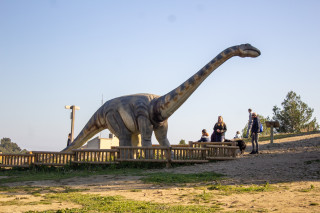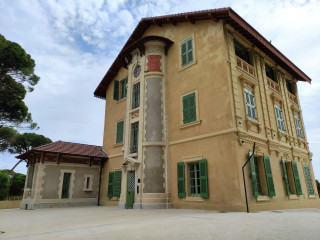Pond story and so many stories" lectures
Cultural Conference Historic Reading LitteratureThursday 23 May 2024
at 18:00
Thursday 20 June 2024
at 18:00
Location : Château des Baumes
Presentation
Discover the history and evolution over the centuries of the Etang de Berre and its inhabitants during a series of lectures by Jean-Philippe LAGRUE, medieval archaeologist and lecturer, from the Division du Patrimoine Culturel Métropolitain.
Conference program :
Thursday, February 01: "Le Pays de l'Etang pendant l'époque Franque (V-IXe siècle)" (The Etang region during the Frankish period (5th-9th century))
Despite the capture of Arles in 416 by the Wizigoths, followed by the dominance of the Ostrogoths (508-536), and the Franks (536-843), Roman rule continued, with international trade attested at Fos. In the hinterland and on the shores of the lake, the economy became more rural, with the reoccupation of villae and the spread of smallholdings. The first saltworks are attested at Lavalduc and Engrenier. At the same time, the oppidas (St-Blaise, Constantine, Ste-Propice in Velaux, St-Michel in Istres...) were reoccupied. With the abdication of the Carolingians in 741, and until the end of the 10th century, Lower Provence saw the return of troubles (invasions and plague), before the Renaissance of the year 1000.
Thursday, February 8: Pays de l'étang in feudal times (11th-13th centuries): castles, churches and territories
At the turn of the year 1000, the establishment of castra (castles) by the powers that be (Archbishop of Arles, families of Les Baux, de Fos and other Porcelets) transformed the area around the Etang de Berre into a political chessboard, giving rise to villages, the origin of today's communes. At the heart of the concerns of those in power and their men were the economic resources derived from the lagoon (salt, fishing, trade) and the territories, which had to be shared and often disputed.
Thursday, March 7: "The autumn of the Middle Ages on the shores of the lake (13th-15th centuries: Angevin peace and a time of misfortune)".
With Charles I's accession to the county (1246), the House of Anjou reigned over Provence until 1480, ensuring a period of prosperity until 1348. Flourishing economic activity (agriculture-trade) led to population and town growth. The reign of Queen Jeanne (1343-1382) coincided with the infamous "trilogy of misfortunes" (wars-plague-disasters). Villages were fortified, while others were depopulated, such as Fos and Gignac, or benefited from an internal exodus (Saint-Mitre, Ferrières).
7. Thursday, April 18: 16th century: wars and Renaissance in the Principality of Martigues
Constituted as a Viscounty in 1471, then integrated into the kingdom of France in 1481, the towns around the lake prepared for Charles V's invasion plans (1524-1536), and then experienced the Wars of Religion (1560-96). As a result, defensive architecture flourished (Lançon, Miramas, Martigues...). At the same time, the countryside was regenerated by Adam Craponne's hydraulic engineering, which led to a proliferation of mills and bastides. In the towns, the aristocracy and local bourgeoisie developed new Hostals. But artistic creations were rare, as evidenced by the altarpieces of Etienne Peson in Saint-Chamas, Sainte-Anne in Marignane and Notre-Dame de Caderot in Berre.
Thursday May 23: The 17th century or the Golden Age of the "Pays de Berre
During the Grand siècle, a return to order and favorable economic conditions enabled the Baroque, the art of the Counter-Reformation and the City, to flourish and express itself through high-quality civil and religious buildings in Martigues, the heart of the Principality of the same name, as well as Marignane with the Château Covet, Saint-Chamas, Salon, Grans, etc. Painting was also well represented.Painting is also well represented, by masters from Marseille or Aix (Michel Serre, Jean Daret) or dynasties of painters (the Blaye family), who work intensively for parish, devotional or penitential churches. This period of grace lasted until the early 18th century, before the crisis and turmoil of the so-called Age of Enlightenment.
Thursday June 20: "18th century: misery, Enlightenment and Revolution
On the banks of the Etang, the early 18th century was marked by tragedies (the harsh winter of 1709, the plague of 1720-1722), which affected the economy, demographics and social climate. This period was also marked by a certain religious laxity on the part of the faithful and priests. However, the churches of Istres, Lançon, La Fare and Grans were rebuilt in a classical style, while the "Regency" or Rococo style appeared on the facades of the mansions in Lançon, Istres and Grans. In the countryside, the Bastides of Ponteau, Lunard and Belval offer fine examples of rustic architecture.
Thursday, February 01: "Le Pays de l'Etang pendant l'époque Franque (V-IXe siècle)" (The Etang region during the Frankish period (5th-9th century))
Despite the capture of Arles in 416 by the Wizigoths, followed by the dominance of the Ostrogoths (508-536), and the Franks (536-843), Roman rule continued, with international trade attested at Fos. In the hinterland and on the shores of the lake, the economy became more rural, with the reoccupation of villae and the spread of smallholdings. The first saltworks are attested at Lavalduc and Engrenier. At the same time, the oppidas (St-Blaise, Constantine, Ste-Propice in Velaux, St-Michel in Istres...) were reoccupied. With the abdication of the Carolingians in 741, and until the end of the 10th century, Lower Provence saw the return of troubles (invasions and plague), before the Renaissance of the year 1000.
Thursday, February 8: Pays de l'étang in feudal times (11th-13th centuries): castles, churches and territories
At the turn of the year 1000, the establishment of castra (castles) by the powers that be (Archbishop of Arles, families of Les Baux, de Fos and other Porcelets) transformed the area around the Etang de Berre into a political chessboard, giving rise to villages, the origin of today's communes. At the heart of the concerns of those in power and their men were the economic resources derived from the lagoon (salt, fishing, trade) and the territories, which had to be shared and often disputed.
Thursday, March 7: "The autumn of the Middle Ages on the shores of the lake (13th-15th centuries: Angevin peace and a time of misfortune)".
With Charles I's accession to the county (1246), the House of Anjou reigned over Provence until 1480, ensuring a period of prosperity until 1348. Flourishing economic activity (agriculture-trade) led to population and town growth. The reign of Queen Jeanne (1343-1382) coincided with the infamous "trilogy of misfortunes" (wars-plague-disasters). Villages were fortified, while others were depopulated, such as Fos and Gignac, or benefited from an internal exodus (Saint-Mitre, Ferrières).
7. Thursday, April 18: 16th century: wars and Renaissance in the Principality of Martigues
Constituted as a Viscounty in 1471, then integrated into the kingdom of France in 1481, the towns around the lake prepared for Charles V's invasion plans (1524-1536), and then experienced the Wars of Religion (1560-96). As a result, defensive architecture flourished (Lançon, Miramas, Martigues...). At the same time, the countryside was regenerated by Adam Craponne's hydraulic engineering, which led to a proliferation of mills and bastides. In the towns, the aristocracy and local bourgeoisie developed new Hostals. But artistic creations were rare, as evidenced by the altarpieces of Etienne Peson in Saint-Chamas, Sainte-Anne in Marignane and Notre-Dame de Caderot in Berre.
Thursday May 23: The 17th century or the Golden Age of the "Pays de Berre
During the Grand siècle, a return to order and favorable economic conditions enabled the Baroque, the art of the Counter-Reformation and the City, to flourish and express itself through high-quality civil and religious buildings in Martigues, the heart of the Principality of the same name, as well as Marignane with the Château Covet, Saint-Chamas, Salon, Grans, etc. Painting was also well represented.Painting is also well represented, by masters from Marseille or Aix (Michel Serre, Jean Daret) or dynasties of painters (the Blaye family), who work intensively for parish, devotional or penitential churches. This period of grace lasted until the early 18th century, before the crisis and turmoil of the so-called Age of Enlightenment.
Thursday June 20: "18th century: misery, Enlightenment and Revolution
On the banks of the Etang, the early 18th century was marked by tragedies (the harsh winter of 1709, the plague of 1720-1722), which affected the economy, demographics and social climate. This period was also marked by a certain religious laxity on the part of the faithful and priests. However, the churches of Istres, Lançon, La Fare and Grans were rebuilt in a classical style, while the "Regency" or Rococo style appeared on the facades of the mansions in Lançon, Istres and Grans. In the countryside, the Bastides of Ponteau, Lunard and Belval offer fine examples of rustic architecture.
Informations
- Accessibility criteria for people with reduced mobility :
- Accessible for self-propelled wheelchairs
- Reserved space 330 cm wide < 100 m from the site
- Lift (80 x 130 cm) and door >= 77 cm
Event Organizer
Office de Tourisme d'Istres
Location
Château des Baumes
Château des Baumes
48 Boulevard Dethez
13800
Istres
- Spoken language(s) :
Tarifs
Free of charge.

FICHE_INFO_SIMPLE_LIBELLE_DESTINATION
Château des Baumes
48 Boulevard Dethez
13800
Istres
GPS coordinates
Latitude : 43.512083
Longitude : 4.983046
- Further information :
- Château des Baumes Place
We also suggest...
Traditions and folklore Cultural Nature and relaxation Guided tour
From Friday 01 March to Saturday 08 June 2024
Every day
-
Further information :
- Office de Tourisme d'Istres Place
Historic site and monument Historic patrimony House
+33 490459614











